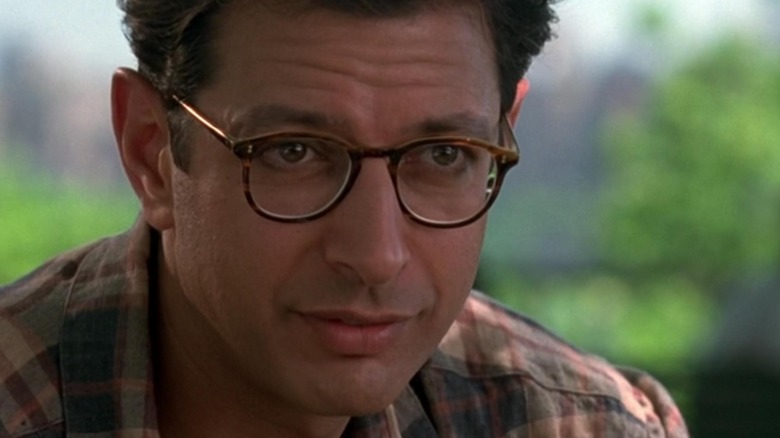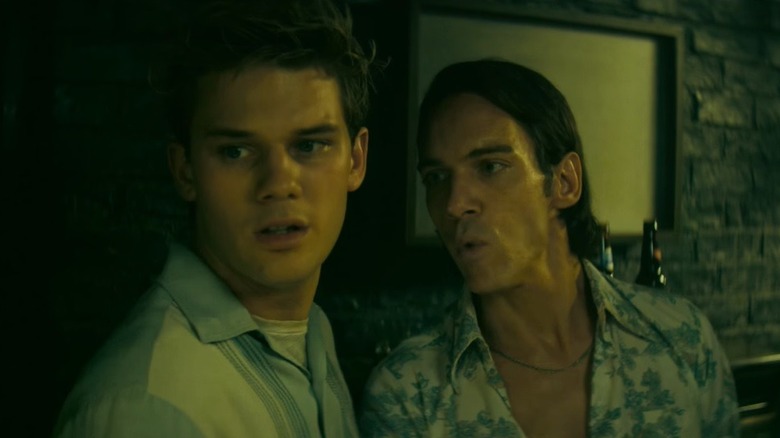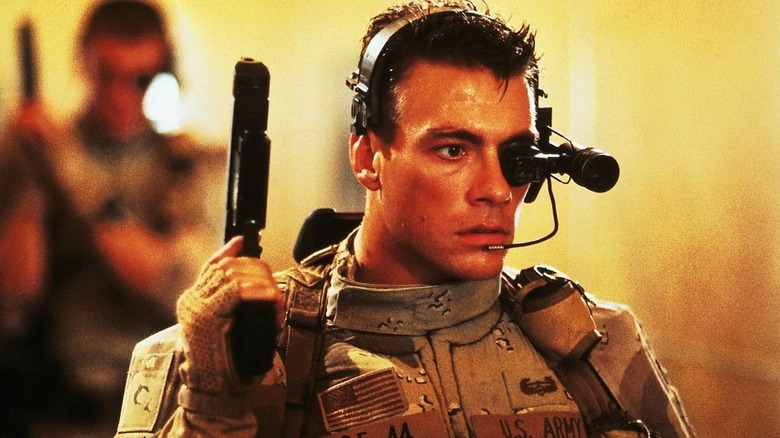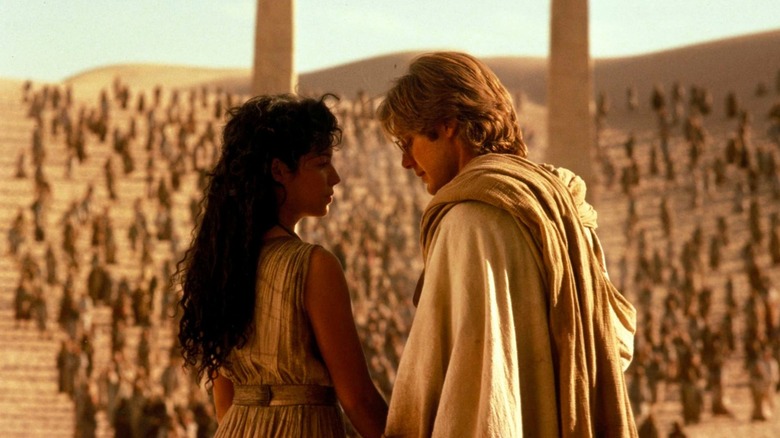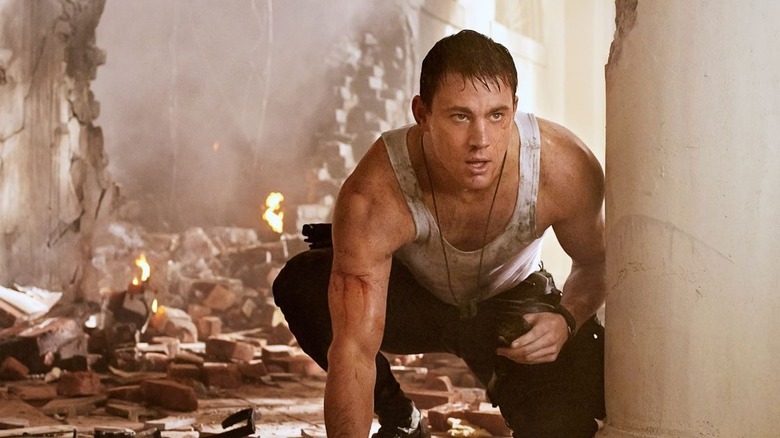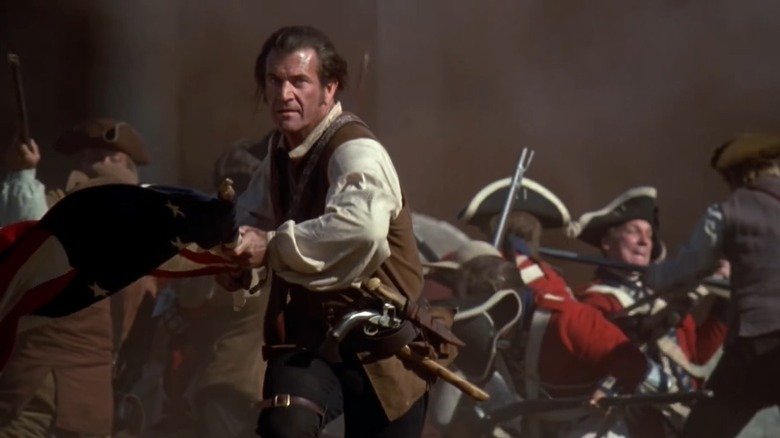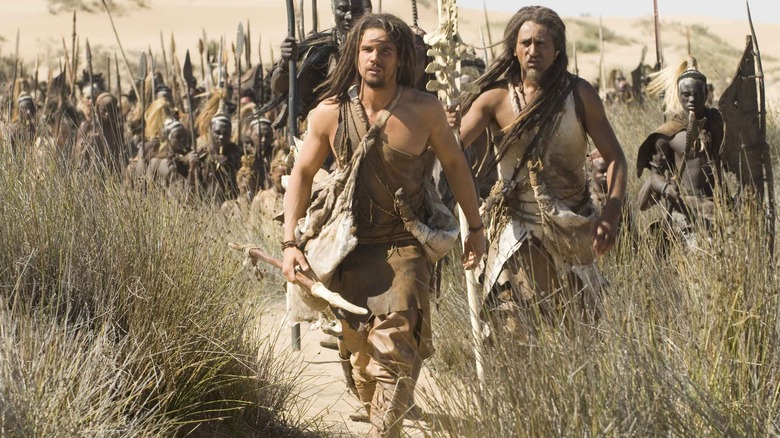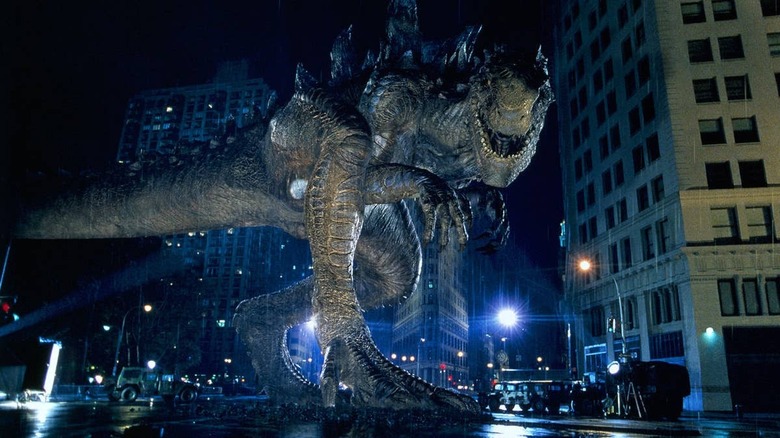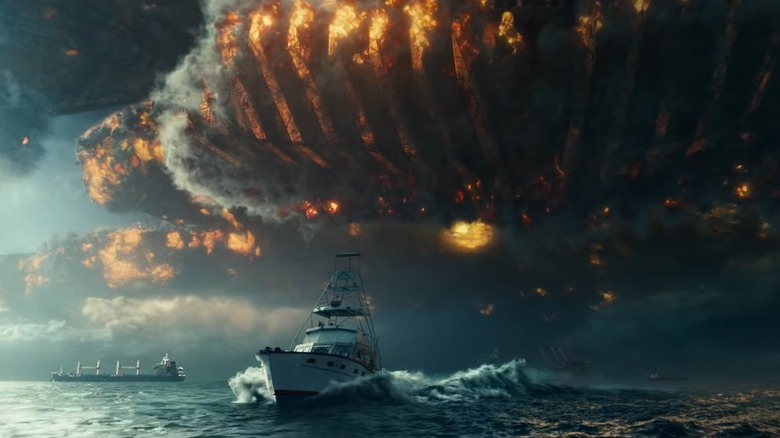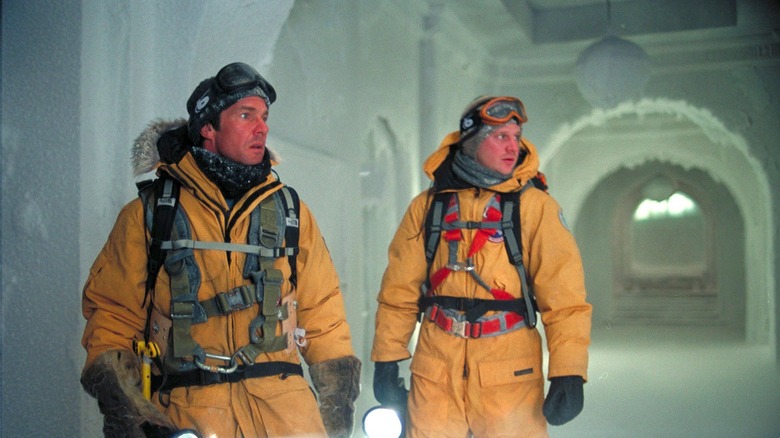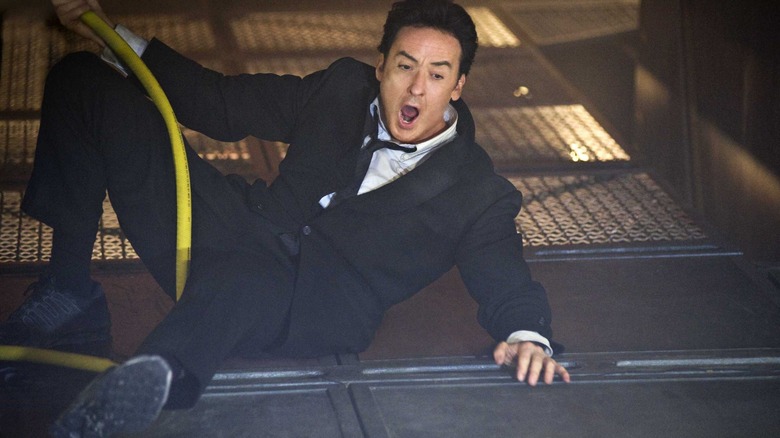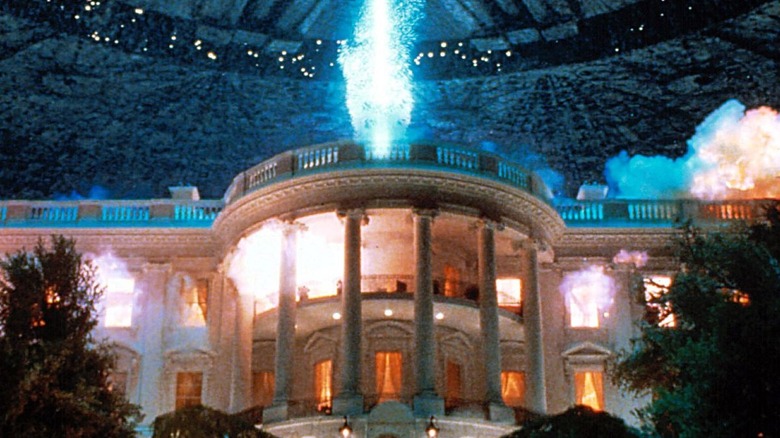Roland Emmerich Movies Ranked By How Much Money They Made
Roland Emmerich's movies have never been consistently critically-acclaimed. They're often chastised for containing unbelievable characters, corny dialogue, and an emphasis on splashy spectacle over substance. At the same time, they've also been consistently profitable ventures, particularly his productions made from "Independence Day" onward. People like to see big things exploding, which is why the disaster movie has had such enduring appeal for decades upon decades. No wonder, then, that moviegoers flock to so many of Emmerich's preposterous blockbusters. No matter how many times he devastates the planet, people seem to always find their way to paying for a ticket to one of his motion pictures.
This streak of box office wins has led to Emmerich accumulating $3.9 billion at the worldwide box office throughout his career, as measured by The Numbers. Of course, when ranking Emmerich's movies by how much money they made globally, it becomes clear that not every single Emmerich directorial effort contributed hefty sums to that cumulative total. His smaller dramas, in particular, have proven far less appealing than his movies about gigantic tidal waves destroying Earth. At the same time, looking at the biggest Emmerich movies ever makes one appreciate his ability to deliver films that resonate across the globe. After all, what's more universally appealing, and reliable for generating major box office, than the sort of apocalyptic carnage only Emmerich can deliver so well?
13. Stonewall
Some movies arrive into theaters on a wave of excitement and positive buzz. However, Roland Emmerich's 2015 feature "Stonewall" hit a handful of arthouse theaters surrounded by toxic word-of-mouth and controversy. As reported by Bustle, all of this conversation was stirring around accusations that Emmerich's film, which chronicled the landmark 1969 Stonewall Inn riots, whitewashed an event made possible by trans women of color by placing young white cis-male gays at the center of the storyline. The very audience that should have felt "Stonewall" a must-see movie event was now protesting it for downplaying key historical figures like Marsha P. Johnson. The writing was on the wall for an inevitably bad box office showing.
As a kiss of death, "Stonewall" got atrocious reviews after its Toronto International Film Festival premiere, per Rotten Tomatoes. Plus, marketing on the project was limited and domestically it never played in more than 129 theaters, a far cry from the 3,500+ theater count of Emmerich's bigger blockbusters. It shouldn't be a surprise, then, that "Stonewall" made a paltry $292,203 at the worldwide box office, $187,674 of which came from North American showings.
It was a disastrous showing on countless levels, including the fact that it remains, to date, the only Emmerich directorial effort to make under $1 million globally. The only real lasting legacy of this box office disaster was how it helped raise consciousness for how even movies about queer history from queer artists can end up engaging in harmful practices of historical whitewashing.
12. Anonymous
After blowing up the world in imaginative ways countless times, Roland Emmerich delivered a creative detour in 2011 with "Anonymous," a Victorian-era drama that explored the conspiracy theory that William Shakespeare didn't write his plays. Under the best of circumstances, this project was not going to have a lot of widespread appeal. This conspiracy theory is just not one that the general public is either aware of or cares much about. The lack of big-name actors in the cast also made the commercial prospects of "Anonymous" doubtful.
Sony/Columbia Pictures, the project's North American distributor, appeared to be conscious of the limited appeal of "Anonymous" since the studio debuted the project in just 265 movie theaters and never brought it into wide release in its run in this territory. It also got burned off at the tail end of October in this region, and it was quickly overwhelmed by other adult-skewing titles opening around the same time. As a result of these release decisions, "Anonymous" grossed just $4.4 million domestically while international territories only added $11.3 million to its plate. Grossing $17.7 million on a $27.5 million budget, "Anonymous" ended up being one of Emmerich's worst performers at the box office. It also became the second-worst performing Sony/Columbia title of 2011 domestically. All the world may be a stage, but that doesn't mean every movie on that stage becomes a star at the box office.
11. Universal Soldier
It's a fact that's gotten overshadowed by the sheer success of the filmmaker's subsequent movies, but Roland Emmerich's directorial debut was on the inaugural installment of the "Universal Soldier" saga. A much smaller-scale affair than his ensuing planet-destroying blockbuster spectacles, "Universal Soldier" kicked off its run as the biggest newcomer at the domestic box office on its opening weekend, handily beating out other fresh titles from that frame like "Cool World." Premiering with $10 million in North America, it eventually grossed $36.2 million worldwide in its box office run. That's a sum future Emmerich features would exceed in their opening weekends, but for the movie's leading man, Jean-Claude Van Damme, the film did prove to be a solid performer.
In the history of Van Damme's box office career, "Universal Soldier" outperformed titles like "Hard Impact" and "Double Target" and proved to be the sixth-biggest live-action movie the actor has ever appeared in. It was also the third-biggest feature Dolph Lundgren showed up in before 2000, making this a notable box office performer for two titans of 1980s actions cinema.
That said, on a $23 million budget, "Universal Soldier" wasn't immensely profitable, though it must've made some money somewhere given how many sequels it spawned. Though nowhere near as massive as, say, "2012," "Universal Soldier" did birth both Emmerich's filmmaking career and his gift for producing movies that register with mass audiences.
10. Midway
In terms of raw numbers, "Midway" didn't perform too shabbily with its $126.8 million worldwide gross. In terms of World War II movies, it was only a bit behind the worldwide box office hauls of other titles in the genre like "The Monuments Men" and "Hacksaw Ridge." More impressively, it pulled off an upset at the North American box office when it debuted as the biggest movie in the territory on its opening weekend, per Business Insider, beating out fellow newcomer "Doctor Sleep" for that honor. Chalk that feat up to the decision to release "Midway" over Veteran's Day weekend as well as the enduring appeal of large-scale war movies to domestic moviegoers. With this surprise victory, it seemed like "Midway" was well on its way to profitability.
Unfortunately, "Midway" had a big problem in the form of its $100 million budget. That's par for the course for a Roland Emmerich movie, but it's a significantly more expensive price tag than other World War II dramas like "Hacksaw Ridge." These costs ensured that "Midway" needed to perform abnormally well for an entry in this subgenre and, after pulling in only $126.8 million globally, it ended up losing money. The lack of both notoriety for the real-world event it was based on and award season glory limited this project's commercial prospects in overseas territories. Despite its numbers, on paper, looking like a surprise hit, "Midway's" budget kept it from being successful. In other words, this project did not hit its intended box office target.
9. Stargate
Long before there was an army of "Stargate" spin-off TV shows, there was the 1994 "Stargate" movie. Of course, nobody believed when this film was preparing to hit movie theaters that "Stargate" would become an enduring staple of pop culture. Released at the end of October 1994, "Stargate" was an original sci-fi drama from a director who'd only helmed one other motion picture.
However, "Stargate" would eventually amass $196.5 million worldwide, with a massive $125 million of that coming from international territories. That was enough to make "Stargate" the 13th biggest movie of 1994 globally, putting it ahead of other projects with familiar brand names like "Maverick" and "Star Trek: Generations." At the time of its release, it was even the biggest Kurt Russell star vehicle by a considerable margin. The film's unique premise resonated with moviegoers while the late October release date allowed "Stargate's" box office haul to take advantage of November holidays like Thanksgiving.
With this hit, Emmerich's financial track record got a major boost. Not only would he continue that streak in the years afterward, but the "Stargate" would keep on entertaining the public much longer than anyone could've predicted.
8. White House Down
In 2012, Channing Tatum got on a hot streak any other actor would envy. Between "The Vow," "21 Jump Street," and "Magic Mike," Tatum had a trio of $100+ million domestic grosses, each leaning heavily on his presence, occupying a different genre, and eschewing the blockbusters sensibilities that dominate modern Hollywood hits. In 2013, it was time for Tatum to return and headline a summer blockbuster in the form of Roland Emmerich's "White House Down." This project would pair Tatum with Jamie Foxx, who was hot off his own 2012 hit film "Django Unchained."
Putting these two together under the watchful eye of Roland Emmerich, who has a great track record for producing effects-heavy hits, should've resulted in a guaranteed smash. Unfortunately, "White House Down" arrived three months after another action movie set in the Oval Office, "Olympus Has Fallen." That film stole "White House Down's" thunder and, combined with a poor release date that put this Emmerich feature opening directly after "Man of Steel" and "World War Z," led to it becoming a box office dud with only $204.4 million globally on a $150 million budget. That's a far cry from the biggest box office hauls Tatum had scored in other parts of his career.
7. The Patriot
After "Godzilla," Roland Emmerich opted to make his next movie a bit different from his last two mega-blockbusters. Though his follow-up directorial effort would still be a costly venture, "The Patriot" was set to be a revenge thriller set in the Revolutionary War, making it a historical drama as well. It would also be a star vehicle for Mel Gibson, an actor who was at the forefront of countless box office hits.
In the end, "The Patriot" would gross $215.3 million worldwide, not a bad sum on its own terms, but just shy of doubling the project's $110 million budget. It also ended up making less than the other two Gibson movies of 2000, "Chicken Run" and "What Women Want," which grossed $227.3 million and $374.1 million worldwide, respectively. Part of the problem here was that "The Patriot" cost way too much for a historical drama, even one starring Gibson, as well as the fact that this project opened the same weekend as sleeper hit "The Perfect Storm." Ironically, the latter title was just the kind of VFX-heavy project Emmerich had deviated from with "The Patriot."
6. 10,000 B.C.
In a modern movie landscape where a new $150+ million budgeted blockbuster is opening in theaters every other week, it can be difficult to imagine a time when blockbusters were confined to the summertime and the last few months of the year. However, that was the status quo for Hollywood as late as 2008, a year that kicked off with a set of financial doldrums. As noted by The Hollywood Reporter, by the end of February 2008, the box office had produced several consecutive weekends that were down from the same timeframe 12 months earlier. Titles like "Semi-Pro" were simply not attracting hordes of moviegoers to their local multiplex. This is where the March 2008 blockbuster "10,000 B.C." came into play as a potential savior for these box office blues.
A period piece action movie opening over the first weekend of March from Warner Bros., the theatrical release of "10,000 B.C." was modeled after "300," which Deadline observes smashed box office records in its March 2007 debut. While the cavemen heroes of "10,000 B.C." didn't come anywhere close to the financial achievements of the Spartans, the film's $269 million global haul on a $105 million budget wasn't too shabby, especially since the film had no famous source material or movie stars to help it out. Plus, it lifted the 2008 box office for a moment. Hard to imagine a film whose worldwide haul was on par with "Spider-Man: No Way Home's" domestic opening weekend, but that used to be the box office norm.
5. Godzilla
When is $376 million at the worldwide box office not enough to be considered a financial success, especially in the 1990s? When you're the 1998 "Godzilla" movie, which arrived into theaters with a significant amount of hype. How could it not? This was the first American take on one of the most famous movie monsters of all time, directed by a guy who just redefined the summer blockbuster with "Independence Day" two years earlier. It was the perfect marriage of material and filmmaker in terms of marketing. However, in terms of artistry, it was a borderline nightmare.
"Godzilla" looked poised to be one of 1998's big box office success stories and it certainly ended up making some coin at movie theaters with a $376 million global haul. That put it behind only two movies at the worldwide box office in 1998. However, that sum was less than half of the worldwide gross of "Independence Day," despite "Godzilla" costing $50 million more to make. Meanwhile, domestically, "Godzilla only made $136.3 million, a sum that put it behind significantly cheaper 1998 titles like "Rush Hour," "There's Something About Mary," and even "Deep Impact." The latter was a disaster movie released a few weeks before "Godzilla" that had no big brand name to boost its marketing. Even with $376 million, "Godzilla" couldn't help but come off as more of the prince of the box office monsters.
4. Independence Day: Resurgence
When it first came out, "Independence Day" was a game-changing blockbuster, one that birthed a new way of doing big-budget action movies and even an enduring movie star in the form of Will Smith. Cut to 20 years later, though, and much had changed in this landscape. The blockbuster movie now belonged to superhero fare while the prospect of a feature containing countless sequences of famous cities going boom was commonplace. A sequel named "Independence Day: Resurgence" would need to do a lot to stand out in this new status quo.
Though it ended up the fourth-biggest Roland Emmerich movie ever worldwide with a $384.1 million global haul, "Resurgence" ended up being a box office disappointment. For one thing, it grossed less than half of what "Independence Day" amassed globally 20 years prior, and that's before taking inflation into account. Plus, it cost $165 million to produce, a price tag that was supposed to yield far more than just $384.1 million. Part of what let "Resurgence" down was a lack of anything new in its marketing campaign, as the trailers and posters just emphasized bigger alien spaceships instead of more unique spectacles or character details.
The lack of Will Smith couldn't have helped things either. Unfortunately, it seems that waiting two decades to produce a follow-up had left "Independence Day" to fall away in the memories of moviegoers rather than build up a solid backlog of nostalgia.
3. The Day After Tomorrow
In 2004, the world was grappling with the concept of global warming. A hot-button topic to bring up on news shows and in documentaries, it's easy to see how the entertainment sector could make the science behind this phenomenon easier to digest. "The Day After Tomorrow" was not looking to accomplish that goal. Instead, this Roland Emmerich disaster movie was more interesting in using the concept of radially changing weather as an excuse to deck New York City in a new ice age.
Though ClimateSight notes that the film is not scientifically accurate, "The Day After Tomorrow's" central premise was unique in the modern blockbuster landscape. Combined with residual positive association with "Independence Day" from nearly a decade prior, "The Day After Tomorrow" became a smash hit at the global box office. Its massive opening weekend helped drive up a record Memorial Day weekend box office haul in North America, per the Los Angeles Times. Its box office achievements didn't end there. When the dust settled, "The Day After Tomorrow" had cracked $555 million at the worldwide box office. An impressive feat that made it the sixth-biggest movie of 2004 globally, "The Day After Tomorrow" rode the political and scientific zeitgeist to financial glory.
2. 2012
In many ways, "2012" was the apotheosis of all Roland Emmerich disaster movies. This wasn't just an alien invasion or global warming suddenly altering Earth. This was the end of the Earth period, as predicted by the Mayans centuries earlier. It was a stroke of genius to build a big-budget blockbuster around the 2012 Mayan prophecy about the end of the world and especially to have Emmerich helm such a project. The global ubiquity of this prophecy meant "2012" was immediately understandable to moviegoers across the planet, resulting in a $757.6 million worldwide haul. International audiences especially gravitated towards this project, with $591.5 million of that cume coming from overseas territories.
It wasn't just the fame of the 2012 prophecy that led to "2012" making so much cash. It also benefited from a great release date, as its mid-November 2009 launch made it the first big-budget blockbuster in theaters in months. Plus, "2012" went bananas with its central premise in figuring out what kind of city-destroying mayhem the end of the world could incur, resulting in plenty of memorable location-specific imagery to plaster on posters and billboards. At this point in his career, Emmerich was also two-for-two in delivering memorable disaster movies with "Independence Day" and "The Day After Tomorrow," giving "2012" a great track record to build off of. These distinctive details were critical to ensuring that "2012" ended up the fifth-biggest movie of 2009 worldwide.
1. Independence Day
The end of the world sounds terrifying. However, in the summer of 1996, audiences couldn't get enough of it by way of "Independence Day." The spectacle of aliens blowing up recognizable landmarks became iconic images everyone couldn't stop talking about, with all the hype resulting in a gargantuan box office haul for this alien invasion project. "Independence Day" made $817.4 million worldwide, an astonishing achievement for a movie that cost $75 million to make. It also topped the 1996 worldwide box office by a considerable margin, with no other title that year managing to make $500 million, let alone $800 million.
It can't be stressed enough just how much of an impact the marketing campaign for "Independence Day," which included a groundbreaking Super Bowl commercial left on the general public, as remembered by Vox. The movie's advertisements turned an original blockbuster with no recognizable brand name into a must-see pop culture phenomenon. It helped, too, that the feature contained an inspirational tone full of cheer-worthy moments, just the kind of aesthetic audiences love most to see in blockbuster projects. Meanwhile, the streamlined narrative made it easy for the production to resonate with audiences across the globe, there were no concerns about the appeal of "Independence Day" getting lost in translation.
The end of the world can be a petrifying thought, but in the context of summer blockbusters, "Independence Day" proved it could be just what the doctor ordered.
